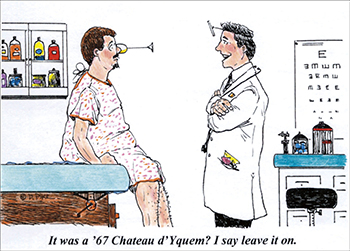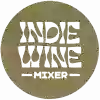The Nose Knows
Aroma a key part of the wine-tasting experience
My book, “Decoding the Grape” began about seven years ago when I wanted to remove some mystifications from wine terms.
The most challenging expressions involve our sense of smell. For example, an Oregon-produced Chardonnay will smell differently from a comparable California wine made of the same varietal. After one or two encounters, we readily can tell the difference. The former may be full of fresh citrus and minerals. The latter gives off strong floral scents and often enough oak to build a writing desk. Then, too, we may mistake the nose by hundreds of miles. Why?
If you can recall the passage where TS Eliot, everyone’s favorite prissy modern poet, describes how, while walking, a person can smell steak cooking as its aroma wafts from an open window, while the same person thinks simultaneously of lovemaking or reading Spinoza. “Noza”— get it?
Eliot addressed an idea about “dissociation of sensibility,” meaning in his modern world, experience had been atomized to the degree individuals became alienated from one another and human experience in all its plenitude was fragmented or reduced to the superficial.

For us, though, smelling that steak will undoubtedly remind us of our desire for such a slab, posted on our plate with a big baked potato, washed down by a gutsy Zinfandel or a supple Merlot. In other words, our olfactory bulb, located directly below our frontal lobes, triggers emotions — I’d love a steak right now — and memory — yes, let’s meet in the bar at The Ringside.
The sense of smell is fascinating to those of us who barely survived high school biology. For instance, humans may possess a capacity to detect trillions of distinct odorants. We do not have, however, the 100-fold capacity of dogs. Or consider some bears that can smell free food from as far away as 18 miles. Salmon, a favorite ursine meal, use smell to know which river is Spawn City — just watch out for the bears.
Finally, women smell better than men — yes, I mean both ways. That is one way a mother distinguishes her child from a changeling.
Odorant molecules actually act like keys to specific neural locks, and these galloping ganglia, in turn, activate our taste buds.
The person who can detect the place of a wine's origin is not merely engaging in a parlor trick. Olfaction fascinates because its myriad degrees impact our emotions, leading us directly to specific memories.
The act of smelling is the main stimulus in appreciating a wine’s merit at the point of tasting and more likely to challenge or confound us.
Then there are people at our table sniffing a cork only to proclaim, “Good nose!” — as if a cork is the personification of WC Fields. You learn very little from a cork unless it signals that it has failed its duty to preserve the wine.
Does a pleasant nose refer to the aroma (smell) or the bouquet (fragrance)? I believe impulse suggests the former as it exists as an effect of the wine in our glasses greeting the air. The latter refers to the sensations we experience as the wine alchemy transforms in the glass.
You may say the aroma derives from the natural characteristics of the varietal. A Sauvignon Blanc often exudes grapefruit and freshly cut grass; while a Pinot Noir suggests cherries or strawberries with a hint of the local hillside.
The bouquet more likely emerges over time as testimony to the skill of the winemaker and post-fermentation process. These aromas enhance the natural smells of the varietals as they also excite us. After all, a wine’s bouquet is a combination of aromas bundled together to form new smells — like a perfume.
If a wine’s bouquet reminds you of Spinoza, I suggest you visit a public library. If it triggers smells like licorice, marzipan or caramel, I say head on down to your neighborhood bakery — leave the wine at home when visiting either place.
Recently, I discovered that a gimme cup does nothing for wine. Not merely does it obscure clarity and color, it also assassinates smells. Its material provides convenience, durability and easy disposal — maybe appropriate for a tailgate party — but it doesn’t, however, do much for allowing wines to breathe, therefore influencing our experience of the wine.
The cork, once removed, and the swirl — once or twice accomplished without dry cleaning — animates the aromas and bouquet of the wine best experienced in a proper wine glass.
The sequence — see, swirl, smell, sip, swallow/spit — affects our perception, participation and summary in the enjoyment of wine. We attend wine tastings rather than wine sightings or sniffing parties. If we separate the wine experience’s components from its important whole, this greatly affects our apprehension and appreciation. Those who want to really discover wines must understand each step.
Just as the dinner guest who sniffs the cork and goes on and on about the provenance of the grapes and other imagined details, please gently advise. “You know that sometimes a cork is just a cork.”


 Ken Friedenreich is writing a book on Oregon wine called “Decoding the Grape.” He contributes to various publications as a wine editor and columnist.
Ken Friedenreich is writing a book on Oregon wine called “Decoding the Grape.” He contributes to various publications as a wine editor and columnist. 









